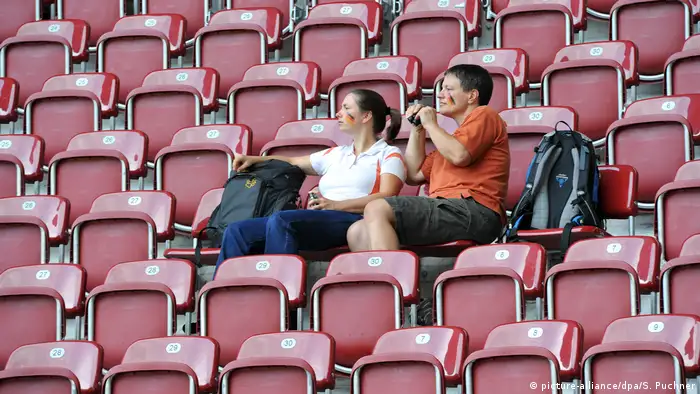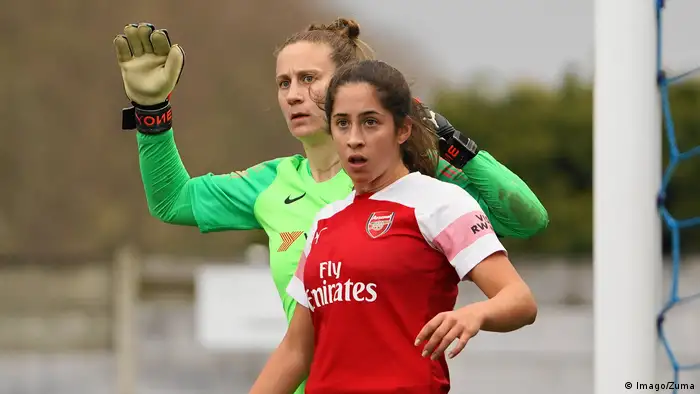Sports
Empty seats: The worrying reality of women's football across Europe
Women's football has made major strides of late, with the highest ever crowd for a club match recorded just days ago. But in Germany, and in other major European leagues, matchday attendances are plummeting.
More than 60,000 people pack into a sun-kissed Wanda Metropolitano to see Spanish giants Atletico Madrid take on Barcelona. Nothing unusual, here. Until, that is, the names of those down on the pitch are read aloud: Vicky, Silvia, Carmen, Marta. The vast crowd was in attendance for a women’s game, the most highly attended ever in European football.
The news came the same week Barclays announced an unparalelled sponsorship deal with England’s Women’s Super League (WSL) worth a reported €12 million over the next three years. In December, Ada Hegerberg become the first recipient of a women’s Ballon D’or, a prize previously only awarded to the best player in the men’s game. This summer France will host a Women’s World Cup expected to break audience records.
Interest in women’s football has never been higher. So why are the numbers of fans actually attending games in Germany and across Europe dwindling?
The reality is different
"More than 60,000 spectators at a women’s game in Spain is clearly a positive step but that was just a one off," Stephan Schmidt, a spokesperson for Turbine Potsdam, one of the most successful clubs in German women’s football, told DW. "The day to day reality is quite different and we’re actually seeing a dramatic decline in the number of fans coming to watch matches."
Schmidt doesn’t believe the World Cup is likely to have a long term impact on attendance figures, which have fallen 25 percent at Turbine over the past five years, regardless of how well Germany fare.
"Five years ago, we could expect around 2,000 spectators at home games but the figure has dropped to around 1,500 per game this season," he said. "If Germany go far in the Women's World Cup then it’s possible those numbers will increase, but a quick boost doesn’t really help anyone. It needs to be sustained over a longer period to be of benefit to the league."
It’s a similar story right across Germany, where numbers are plummeting regardless of on-field success. Wolfsburg’s women’s team, reigning Bundesliga champions and back-to-back winners of the Women’s Champions League in 2013 and 2014, have also seen crowds leaving in droves.
Five years ago, Wolfsburg were drawing in average crowds of around 2,400 per league game. That figure is now around 1,300; a 42 percent drop in average gate figures.
Bayern Munich Women, meanwhile, have seen numbers stay pretty much the same, with an average increase of just 97 spectators at games over the last five years. A paltry figure, and one which owes more to the men's side than the women, according to Schmidt.
"Bayern benefit from the huge popularity of their men’s team," he explained. "If fans can't attend an FC Bayern game, for whatever reason, they can go and see a women’s game."
European wide issue
It’s not just Germany either, other nations have struggled to maintain matchday attendances despite great strides in other areas of the women’s game.
In France, Lyon, widely-regarded as the best women’s team in Europe and winner of three Champions League titles in a row between 2015 and 2018, have seen average gates nosedive since five years ago, from more than 4,500 in 2013-14 to fewer than 1,000 this campaign. Montpellier’s gate has dropped 49 percent, Guingcamp's, 35 percent.

Olympique Lyon lift a third-straight Champions League title after defeating PSG in Cardiff last June.
Matchday figures are also falling across the board in Spain and Italy, with the Spanish clash between Atletico and Barcelona appearing even more of an anomaly when taking regular league gates into account.
England buck the trend
England’s WSL is one of the only major European footballing leagues not experiencing this decline. Chelsea Ladies, the reigning champions, have seen average crowds rise almost 75 percent across the past five years, from 503 in 2013-14 to 1,965 this. Manchester City have seen their average gate rise 40 percent, to just over 1,600 in 2018-19. It’s a pattern repeated across the league.
"Women's football is really making strides in this country," Daniel Ferguson, Women's Marketing Manager at the WSL, told DW. "More matches are being shown on TV and we're seeing huge investment in the game both from sponsors and men's clubs."
"The WSL is teaching clubs to market themselves better so they can capitalize on the increased awareness. Focusing on the right groups is key; girls between the ages of seven and 15 who play football and are likely to maintain a long term interest in the game."
Unsurprisingly, Ferguson is less pessimistic about the effects this summer's World Cup could have on attendances.
"We're hoping this tournament will cause women's football to explode into the mainstream," he said. "We saw a 33 percent increase in attendances immediately after the 2015 World Cup and, if England go far this summer, it could be ever bigger this year. We want to build on that success and inspire the next generation of girls to get involved ahead of Euro 2021, which is being played on home soil."
As interest around women's international football rises, the WSL is aiming to channel that interest into its domestic leagues. Focusing on key demographics and improving the matchday experience at women's games is key to this and rival nations should take note.
While there's no denying women's football is growing in myriad ways, reaching new audiences globally and inspiring more young women than ever to join local clubs, figures from across the continent cast a concerning light on the state of the game on professional domestic level.
Grumblings about the pay gap between male and female footballers are well founded given the extremity of the disparity, but many believe things aren't going to change until fans can be persuaded to put their hands in their pockets for domestic league matches.
Sellouts and 60,000 crowds are a nice headline. But until things improve for clubs across Europe on a weekly basis, that seems to be all they are.
.
DW recommends
- Date 22.03.2019
- Author Ed McCambridge
- Related Subjects Borussia Dortmund, Bayern Munich, Bundesliga, Champions League
- Keywords Bundesliga, Champions League, Premier League, Bayern Munich, Germany women's football, Chelsea, Manchester City
- Feedback: Send us your feedback.
- Print Print this page
- Permalink https://p.dw.com/p/3FQe4
- Date 22.03.2019
- Author Ed McCambridge
- Related Subjects Borussia Dortmund, Bayern Munich, Bundesliga, Champions League
- Keywords Bundesliga, Champions League, Premier League, Bayern Munich, Germany women's football, Chelsea, Manchester City
- Send us your feedback.
- Print Print this page
- Permalink https://p.dw.com/p/3FQe4






